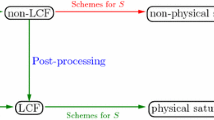Abstract
Solution of Laplace’s equation can be done by iteration methods likes Jacobi, Gauss–Seidel, and successive over-relaxation (SOR). There is no new knowledge about the relaxation coefficient (ω) in SOR method. In this paper, we used SOR for solving Laplace’s differential equation with emphasis to obtaining the optimum (minimum) number of iterations with variations of the relaxation coefficient (ω). For this purpose, a code in FORTRAN language has been written to show the solution of a set of equations and its number of iterations. The results demonstrate that the optimum value of ω with minimum iterations is achieved between 1.7 and 1.9. Also, with increasing β = ∆x/∆y from 0.25 to 10, the number of iterations reduced and the optimum value is obtained for β = 2.








Similar content being viewed by others
Abbreviations
- ω :
-
Relaxation coefficient
- Δx :
-
Computational grid interval in the x direction
- Δy :
-
Computational grid interval in the y direction
- β :
-
\( \Delta x/\Delta y\,{\text ratio} \,of\,\Delta x\,{\text{per}}\,\Delta y \)
- K :
-
Hydraulic conductivity
- c :
-
Slope of the water table
- h :
-
Groundwater head
- h i,j m :
-
Head in i,j node and time interval m
- y 0 :
-
Assumed initial head at x = 0
- s :
-
Maximum length in the x direction
- q :
-
Unit width discharge
- q x , q y :
-
Discharges per unit width in the x and y directions, respectively
- Δt :
-
Time increment
- g :
-
Gravitational acceleration
- j :
-
jth grid point value
- i :
-
ith grid point value
References
Bennett GD (1976) Introduction to ground water hydraulics: a programmed text for self-instruction. Techniques of water resources investigations, book 3, chapter B2. U.S. Geological Survey, 172 pp
Freeze RA, Witherspoon PA (1966) Theoretical analysis of regional groundwater flow: 1. Analytical and numerical solutions to the mathematical model. Water Resour Res 2(4):641–656
Freeze RA, Witherspoon PA (1967) Theoretical analysis of regional groundwater flow: 2. Effect of water-table configuration and subsurface permeability variation. Water Resour Res 3(2):623–634
Freeze RA, Witherspoon PA (1968) Theoretical analysis of regional groundwater flow: 3. Quantitative interpretations. Water Resour Res 4(3):581–590
McBride MS, Pfannkuch HO (1975) The distribution of seepage within lakebeds. US Geol Surv J Res 3(5):505–512
Remson I, Hornberger GM, Molz FJ (1971) Numerical methods in subsurface hydrology. Wiley Interscience, New York, 389 pp
Singh TN, Pradhan SP, Vishal V (2012) Stability of slopes in a fire-prone mine in Jharia Coalfield, India. Arab J Geosci. doi:10.1007/s12517-011-0341-4
Surinaidu L, Gurunadha Rao VVS, Ramesh G (2012) Assessment of groundwater inflows into Kuteshwar Limestone Mines through flow modeling study, Madhya Pradesh, India. Arab J Geosci. doi:10.1007/s12517-011-0421-5
Tamma Rao G, Gurunadha Rao VVS, Surinaidu L, Mahesh J, Padalu G (2012) Application of numerical modeling for groundwater flow and contaminant transport analysis in the basaltic terrain, Bagalkot, India. Arab J Geosci. doi:10.1007/s12517-011-0461-x
Toth J (1962) A theory of groundwater motion in small drainage basins in Central Alberta, Canada. J Geophys Res 67(11):4375–4387
Wang HF, Anderson MP (1982) Introduction to groundwater modeling: finite difference and finite element methods. Academic, New York, 237 pp. ISBN-13: 978–0127345857
Author information
Authors and Affiliations
Corresponding author
Rights and permissions
About this article
Cite this article
Salmasi, F., Azamathulla, H.M. Determination of optimum relaxation coefficient using finite difference method for groundwater flow. Arab J Geosci 6, 3409–3415 (2013). https://doi.org/10.1007/s12517-012-0591-9
Received:
Accepted:
Published:
Issue Date:
DOI: https://doi.org/10.1007/s12517-012-0591-9



